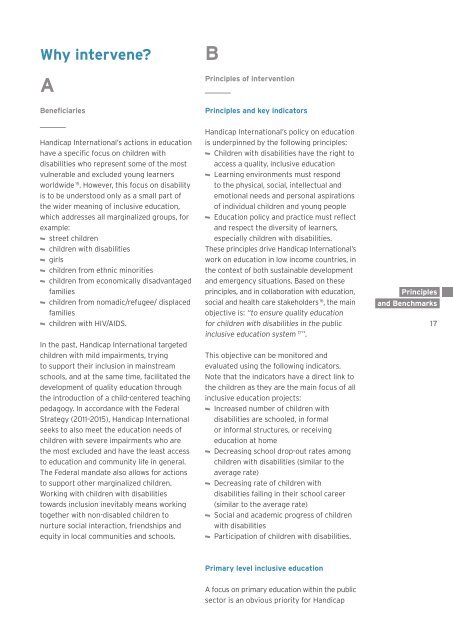Inclusive Education : Policy paper - Hiproweb.org
Inclusive Education : Policy paper - Hiproweb.org
Inclusive Education : Policy paper - Hiproweb.org
You also want an ePaper? Increase the reach of your titles
YUMPU automatically turns print PDFs into web optimized ePapers that Google loves.
Why intervene?<br />
A<br />
Beneficiaries<br />
B<br />
Principles of intervention<br />
Principles and key indicators<br />
Handicap International’s actions in education<br />
have a specific focus on children with<br />
disabilities who represent some of the most<br />
vulnerable and excluded young learners<br />
worldwide 15 . However, this focus on disability<br />
is to be understood only as a small part of<br />
the wider meaning of inclusive education,<br />
which addresses all marginalized groups, for<br />
example:<br />
street children<br />
children with disabilities<br />
girls<br />
children from ethnic minorities<br />
children from economically disadvantaged<br />
families<br />
children from nomadic/refugee/ displaced<br />
families<br />
children with HIV/AIDS.<br />
In the past, Handicap International targeted<br />
children with mild impairments, trying<br />
to support their inclusion in mainstream<br />
schools, and at the same time, facilitated the<br />
development of quality education through<br />
the introduction of a child-centered teaching<br />
pedagogy. In accordance with the Federal<br />
Strategy (2011–2015), Handicap International<br />
seeks to also meet the education needs of<br />
children with severe impairments who are<br />
the most excluded and have the least access<br />
to education and community life in general.<br />
The Federal mandate also allows for actions<br />
to support other marginalized children.<br />
Working with children with disabilities<br />
towards inclusion inevitably means working<br />
together with non-disabled children to<br />
nurture social interaction, friendships and<br />
equity in local communities and schools.<br />
Handicap International’s policy on education<br />
is underpinned by the following principles:<br />
Children with disabilities have the right to<br />
access a quality, inclusive education<br />
Learning environments must respond<br />
to the physical, social, intellectual and<br />
emotional needs and personal aspirations<br />
of individual children and young people<br />
<strong>Education</strong> policy and practice must reflect<br />
and respect the diversity of learners,<br />
especially children with disabilities.<br />
These principles drive Handicap International’s<br />
work on education in low income countries, in<br />
the context of both sustainable development<br />
and emergency situations. Based on these<br />
principles, and in collaboration with education,<br />
social and health care stakeholders 16 , the main<br />
objective is: “to ensure quality education<br />
for children with disabilities in the public<br />
inclusive education system 17 ”.<br />
This objective can be monitored and<br />
evaluated using the following indicators.<br />
Note that the indicators have a direct link to<br />
the children as they are the main focus of all<br />
inclusive education projects:<br />
Increased number of children with<br />
disabilities are schooled, in formal<br />
or informal structures, or receiving<br />
education at home<br />
Decreasing school drop-out rates among<br />
children with disabilities (similar to the<br />
average rate)<br />
Decreasing rate of children with<br />
disabilities failing in their school career<br />
(similar to the average rate)<br />
Social and academic progress of children<br />
with disabilities<br />
Participation of children with disabilities.<br />
Principles .<br />
and Benchmarks .<br />
17<br />
Primary level inclusive education<br />
A focus on primary education within the public<br />
sector is an obvious priority for Handicap

















